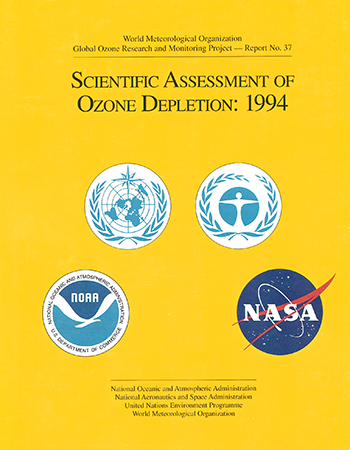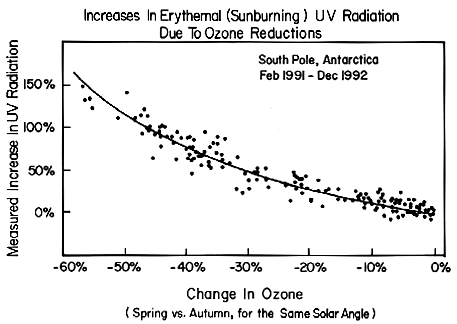Scientific Assessment of Ozone Depletion: 1994
Common Questions About Ozone

7. Is the Depletion of the Ozone Layer Leading to an Increase in Ground-Level Ultraviolet Radiation?
The Sun emits light over a wide range of energies, with about two percent given off in the form of high-energy, ultraviolet (UV) radiation. Some of this UV radiation (UV-B) is especially effective in causing damage to living things, including sunburn, skin cancer, and eye damage for humans. The amount of solar UV radiation received at any particular location on the Earth's surface depends upon the position of the Sun above the horizon, on the amount of ozone in the atmosphere, and upon local cloudiness and pollution. Scientists agree that in the absence of changes in clouds or pollution, decreases in atmospheric ozone will increase ground-level UV radiation.
The largest decreases in ozone during the last decade have been observed over Antarctica, especially during each September and October when the "ozone hole"forms. During the last several years, simultaneous measurements of UV radiation and total ozone have been made at several Antarctic stations. As shown in the figure below, when the ozone amounts decrease, UV-B increases. Because of the ozone hole, the UV-B intensity at Palmer Station, Antarctica, in late October, 1993, was more intense than found at San Diego, California, at any time during all of 1993.
In areas where small ozone depletion has been observed, UV-B increases are more difficult to detect. Detection of UV trends associated with ozone decreases can also be complicated by changes in cloudiness or by local pollution, as well as by difficulties in keeping the detection instrument in precisely the same condition over many years. Prior to the late 1980s, instruments with the necessary accuracy and stability for measurement of small long-term trends in ground-level UV-B were not employed. Recently, however, such instruments have been used in the Antarctic because of the very large changes in ozone being observed there. When high-quality measurements have been made in other areas far from major cities and their associated air pollution, decreases in ozone have regularly been accompanied by increases in UV-B. The data from urban locations with older, less specialized instruments provide much less reliable information, especially because good simultaneous measurements are not available for any changes in cloudiness or local pollution.
